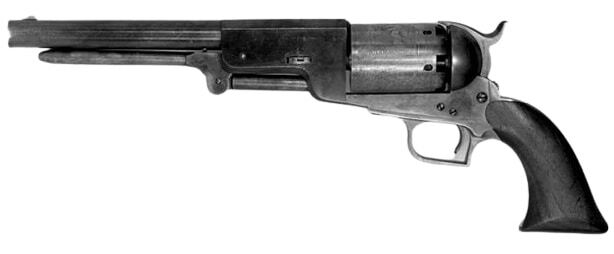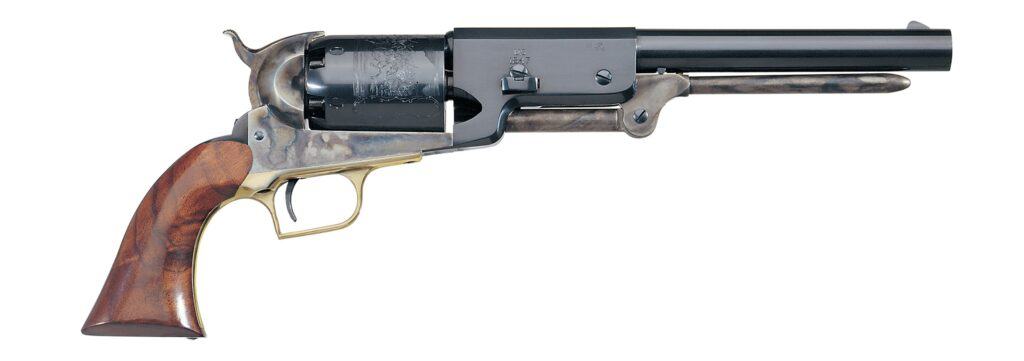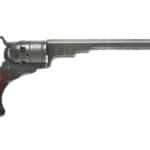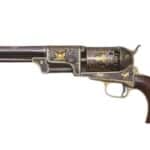
Introduction
Just as the Battle of Thermopylae echoed throughout history, so too did the thunderous roar of the Colt Walker revolver, a leviathan of a handgun that reshaped the landscape of firearms. This was no ordinary weapon—it was the most powerful black powder revolver ever issued, a harbinger of the modern repeating handgun, and an enduring symbol of the rugged frontier.
The Need for the Colt Walker Revolver
The genesis of the Colt Walker revolver can be traced to the tumultuous period of the Mexican-American War (1846–1848). Captain Samuel Hamilton Walker, a battle-hardened veteran of the Texas Rangers and the U.S. Mounted Rifles, had firsthand experience with the limitations of contemporary sidearms. The Paterson revolver—Colt’s earliest commercial repeating handgun—was elegant but fragile, underpowered, and held only five rounds. Walker envisioned something far more potent: a six-shot revolver with stopping power capable of putting down both enemy combatants and their horses with a single shot.
In 1846, Walker personally met with Samuel Colt, whose original Patent Arms Manufacturing Company had gone bankrupt following the Paterson's commercial failure. Walker’s concept aligned perfectly with Colt’s ambition to revive his firearms business. The result of this partnership was a revolutionary new firearm—the Colt Walker revolver, officially adopted by the U.S. military in 1847.
Manufacturing and Development
The U.S. Ordnance Department promptly placed an order for 1,000 Colt Walker revolvers, along with 100 additional units for civilian sale. Due to the collapse of his prior business, Colt lacked the facilities to produce them himself, so he partnered with Eli Whitney Jr. (son of the inventor of the cotton gin) to manufacture the revolvers at the Whitneyville Armory in Connecticut.

Each Colt Walker was meticulously crafted, though manufacturing imperfections and metallurgical limitations meant that some cylinders failed under the immense pressures of their powerful powder charges. Despite these issues, the Walker was a game-changer on the battlefield.
Physical Attributes and Ballistics
The Colt Walker was, and remains, a giant among handguns. With an overall length of 15.5 inches and an unloaded weight of approximately 4.5 pounds, it dwarfed other sidearms of its time. The revolver was chambered in .44 caliber and was capable of firing approximately 140 grain with up to 60 grains of black power or a 220- to 255-grain conical bullet propelled by a smaller black powder charge—one of the most powerful handgun loads of the 19th century. This immense firepower allowed the Walker to generate muzzle velocities of up to 1,200 feet per second, delivering energy in excess of 500 foot-pounds—rivaling some modern magnum revolvers.
The revolver featured a single-action mechanism and a six-shot cylinder, a marked improvement over the Paterson's five-round capacity. It also introduced a permanently attached loading lever, preventing users from misplacing the essential tool.
Combat Effectiveness and Drawbacks
The Walker’s effectiveness was undeniable. It had an extended range compared to other handguns of the period, capable of striking targets at 100 yards with accuracy superior to smoothbore pistols. The immense kinetic energy ensured that it could penetrate wood, soft body armor, and even the hulls of riverboats—qualities that made it a favorite among cavalrymen and Texas Rangers.
However, the revolver was not without its flaws. Its enormous weight made it impractical for belt carry, leading many users to holster it on their saddles. The sheer power of its 60-grain powder charge placed significant stress on its cylinder walls, occasionally causing catastrophic failures. Additionally, the Walker’s loading lever had a tendency to drop under recoil, inadvertently jamming the firearm mid-battle. These shortcomings were later addressed in the Colt Dragoon series, which featured a reduced powder charge, reinforced construction, and an improved loading lever latch.
The Walker in History: Famous Users and Incidents
The Colt Walker was wielded by some of the most legendary figures of the Old West. Captain Walker himself carried a pair of engraved Walkers into battle, but he was tragically killed in action at the Battle of Huamantla in 1847 before seeing the full impact of his design. His namesake revolver, however, went on to play a critical role in various conflicts.
The Walker saw action not only in the Mexican-American War but also in frontier skirmishes, notably used by Texas Rangers such as "Bigfoot" Wallace. Wallace, one of the most feared lawmen of his era, reportedly carried a pair of Walkers and was never bested in a gunfight. The revolver was also used during the Utah War (1857) and numerous clashes with Native American warriors across the Western frontier.
The Walker’s Legacy in Firearms History
The impact of the Colt Walker on firearm evolution cannot be overstated. It set the standard for future Colt revolvers, including the Dragoons, 1860 Army, and eventually the Single Action Army. More importantly, it revitalized Samuel Colt’s career, enabling him to establish the Colt empire that dominated American sidearm production for the next century.
Many elements of the Walker’s design—including its large caliber, six-shot cylinder, and robust single-action mechanism—became mainstays in revolver development. Some historians argue that the Walker was the first true magnum revolver, as it remained the most powerful commercially produced repeating handgun until the introduction of the .357 Magnum in 1935.
Modern-Day Replicas and Collectibility

Today, original Colt Walkers are among the most sought-after collectibles in the firearms world, with surviving specimens fetching upwards of $1 million at auction. Because of their historical significance and scarcity, collectors prize them above nearly all other antique revolvers.
For those looking to experience the Walker firsthand, Italian firearms manufacturers such as Uberti and Cimarron produce high-quality reproductions. These replicas maintain historical accuracy while using modern metallurgy to ensure safety and reliability. Shooters who fire these reproductions often remark on their substantial weight, powerful recoil, and impressive accuracy, making them a favorite among black powder enthusiasts.
Conclusion: A True American Icon
The Colt Walker revolver remains one of the most legendary handguns ever created. It was more than just a firearm; it was a statement of power, ingenuity, and the relentless spirit of the American frontier. From the battlefields of the Mexican-American War to the holsters of Texas Rangers, the Walker left an indelible mark on history, serving as the foundation for all revolvers that followed.
While its thunderous roar may have faded into history, the Walker’s legacy endures—a testament to the brilliance of Samuel Colt and the unyielding determination of Captain Walker. For firearm historians, collectors, and shooting enthusiasts, the Colt Walker remains the undisputed king of black powder revolvers, its legend as potent today as it was in 1847.
To join the discussion this and similar firearms, join the forum here..
Read more about the Colt Walker here:
If you know of any forums or sites that should be referenced on this listing, please let us know here.







